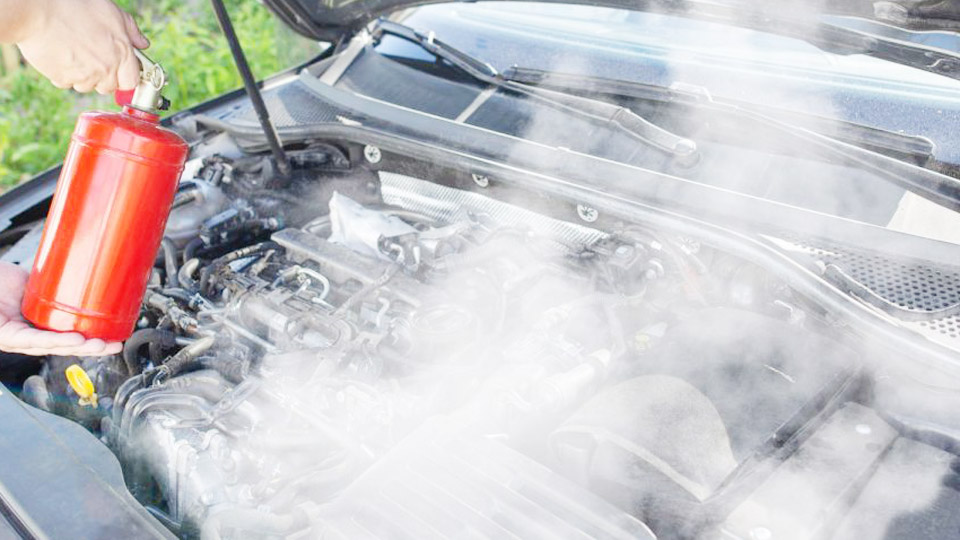Why Does My Car Overheat When I Stop?
If you’ve ever found yourself asking, “Why does my car overheat when I stop?” you’re not alone. As someone who’s spent years diving into the world of automotive care and repair, I’ve seen this issue pop up time and time again. It’s frustrating, isn’t it? You’re driving along, everything seems fine, but the moment you pause at a traffic light or in a drive-thru, that temperature gauge starts climbing.
I’m here to walk you through the reasons, the fixes, and everything in between. Let’s get under the hood and solve this mystery together in a way that’s easy to understand and practical for anyone in the USA dealing with this pesky problem.

Photo by hubpages
Basics of Car Overheating
| # | Preview | Product | |
|---|---|---|---|
| 1 |

|
Car Detailer Don't Stop When I'm Tired I Stop When I'm Done T-Shirt | Check Price on Amazon |
Your car’s engine is like a hardworking chef in a busy kitchen, constantly cooking up power to keep you moving. All that work generates heat—tons of it! Normally, your car’s cooling system acts like a trusty sous-chef, keeping the temperature in check. It uses a mix of coolant, a radiator, fans, and other parts to pull heat away from the engine and release it into the air. When you’re cruising down the highway, airflow helps cool things down naturally.
But when you stop—say, at a red light or in traffic—that airflow drops, and the engine can start to feel the heat. If something’s not working right, that’s when trouble begins. Overheating happens when the engine gets too hot, and if it’s ignored, it can damage parts, cost you big bucks, or leave you stranded. Let’s explore why this happens specifically when you stop.
Common Reasons Your Car Overheats When Stopped
I’ve tinkered with countless cars and talked to drivers across the USA, and I’ve found a handful of usual suspects behind this issue. When your car’s at a standstill, the cooling system has to work harder without the help of rushing air. Here are the top reasons I’ve come across that could be making your car overheat when you stop.
A Faulty Radiator Fan
Think of your radiator fan as your car’s personal breeze-maker. When you’re stopped, there’s no wind from driving to cool the radiator, so the fan kicks in to move air through it and chill the coolant. If the fan’s broken, clogged with debris, or not getting power, the heat builds up fast.
I’ve seen fans fail because of a blown fuse, a bad motor, or even a loose wire. Without that airflow, your engine’s temperature creeps up, and that gauge starts to climb. It’s one of the first things I check when a car overheats at a stop.
Low Coolant Levels
Coolant is the lifeblood of your cooling system—it absorbs heat from the engine and carries it to the radiator to cool off. If your coolant’s low, there’s not enough to do the job. I’ve found leaks from hoses, the radiator, or even the water pump in so many cases.
It’s just evaporated over time or wasn’t refilled properly. When you’re stopped, the little coolant that’s left can’t keep up, and the engine gets hot. Always check your coolant level—carefully, though, when the engine’s cool—so you don’t get burned!
A Malfunctioning Thermostat
The thermostat is like a gatekeeper, controlling when coolant flows to the radiator. When your engine warms up, it’s supposed to open and let coolant circulate. But if it’s stuck closed, the coolant can’t move, and heat gets trapped in the engine. I’ve replaced plenty of thermostats that failed this way, especially in older cars.
When you’re driving, some air might help, but at a stop, the heat has nowhere to go. It’s a sneaky problem, but a common one I’ve seen over the years.
A Clogged Radiator
Your radiator’s job is to cool the coolant, but if it’s clogged with dirt, bugs, or rust, it can’t do that well. I’ve peered into radiators and found all sorts of gunk blocking the fins or tubes inside.
When you’re moving, air might push through enough to help, but when you stop, the reduced airflow and blockage team up to trap heat. It’s like trying to breathe through a straw that’s half-plugged—tough work! A good cleaning or flush often saves the day here.
Water Pump Issues
The water pump keeps coolant flowing through the engine and radiator. If it’s failing—maybe the impeller’s worn out or it’s leaking—the circulation slows down or stops. I remember a time I helped a friend whose car overheated at every stoplight; we found the water pump was barely pumping! When you’re stopped, the lack of flow means heat piles up fast. It’s not always easy to spot, but it’s a critical piece of the puzzle.
Other Potential Culprits
Sometimes, the issue is a bit trickier. A bad head gasket can let exhaust gases sneak into the cooling system, heating things up. I’ve also seen worn belts or hoses that slip or leak, slowing the system down. Even a faulty temperature sensor might trick your car into thinking it’s fine when it’s not, so the fan doesn’t turn on. These aren’t as common, but I’ve learned to keep an eye out for them after years of troubleshooting.
How to Diagnose the Problem
Okay, so your car’s overheating when you stop—let’s figure out why! I always start with simple checks you can do safely at home. First, when the engine’s cool, pop the hood and look at the coolant level in the reservoir. Is it low? Look for leaks—puddles under the car or wet spots on hoses.
Next, watch the radiator fan when you’re stopped. Does it spin up when the engine gets warm? Listen for odd noises, too, like grinding from the water pump. If you’re comfortable, feel the radiator—uneven hot and cold spots might mean a clog.
I’ve done this dozens of times, and it’s amazing how much you can learn just by looking and listening. If it’s tricky or you’re unsure, I’d take it to a trusted mechanic. They’ve got tools like pressure testers and scanners to dig deeper.
Steps to Fix a Car That Overheats When Stopped
Good news—you can tackle some of these fixes yourself, and I’m here to guide you! Here’s how I’d approach it based on what I’ve learned fixing cars over the years.
Check and Refill Coolant
Start easy: check the coolant when the engine’s cold. Look at the reservoir—most cars have a “min” and “max” line. If it’s low, grab a 50/50 mix of antifreeze and water (common in the USA at auto stores) and top it off. I’ve done this for my own car plenty of times. Look for leaks, too—if it keeps dropping, something’s dripping, and you’ll need to fix that.
Inspect the Radiator Fan
Peek at the fan when the engine’s warm—does it turn on? If not, check the fuse under the hood (your manual shows where). A blown fuse is an easy fix—just replace it with the right size. If the fan’s dead, you might need a new one. I’ve swapped fans before; it’s doable with basic tools, but a mechanic can handle it if you’re not comfy.
Replace the Thermostat
A stuck thermostat isn’t too hard to change. It’s usually near the engine, bolted in place. Drain some coolant, unbolt it, pop in a new one, and refill the coolant. I’ve done this in my driveway—it takes an hour or so. Get the right part for your car model; check your manual or ask at the auto store.
Clean or Flush the Radiator
Grab a brush and gently clean the radiator’s front—dirt and bugs love to stick there. For inside clogs, a radiator flush (buy a kit at the store) can help. Drain the old coolant, pour in the flush, run the engine as directed, then refill with fresh coolant. I’ve seen this cool things down like magic!
Address Water Pump Problems
This one’s tougher. If you hear a whine or see leaks near the water pump, it might be shot. Replacing it means draining coolant, removing belts, and bolting on a new pump. I’ve helped friends with this, but it’s a job I’d often leave to a pro unless you’ve got experience.
When to Call a Professional
If you spot a head gasket issue—think steam, odd exhaust, or milky oil—don’t wait. I’ve seen these repairs get pricey, so a mechanic with the right tools is your best bet. Same goes if the fixes don’t work or you’re not sure. Safety first!
Preventative Tips to Avoid Overheating
I love helping folks keep their cars running cool. Here’s what I do to prevent this headache. Check your coolant monthly—top it off if needed. Peek at the fan and radiator for dirt or damage. I always keep an eye on the temperature gauge; if it’s creeping up, I pull over safely.
Flush the cooling system every couple of years—most manuals suggest this. Use the right coolant for your car, too. And don’t skip regular tune-ups—keeping belts and hoses tight and leak-free saves trouble. I’ve avoided so many issues this way!
How Overheating Affects Your Car’s Longevity
Let me tell you, overheating isn’t just a nuisance—it can hurt your car big time. I’ve seen engines warp or crack from too much heat, and that’s thousands in repairs. Gaskets blow, hoses burst, and parts wear out faster. I once knew a guy who ignored it, and his engine seized—total loss! Keeping the cooling system happy means your car lasts longer, runs better, and saves you cash. Trust me, a little care goes a long way.
Common Symptoms and Warning Signs
Wondering if your car’s in trouble? I’ve noticed these clues when overheating hits at a stop. The temperature gauge climbs past the middle—watch that! You might see steam or smell a sweet scent from coolant. The heater might blow cold air, or you’ll hear a weird noise from the engine. If a warning light pops on, don’t ignore it. I always tell folks: catch it early, and you’ll save a lot of stress.
Quick Reference: Troubleshooting Table
Here’s a handy table I’ve put together from my experience to help you pinpoint the issue fast.
| Issue | Symptoms | DIY Fix | When to Get Help |
|---|---|---|---|
| Low Coolant | Gauge rises, possible leaks | Check level, refill coolant | Leaks persist |
| Faulty Radiator Fan | No fan spin, hot at stop | Check fuse, clean fan | Fan won’t run |
| Stuck Thermostat | Gauge spikes, no circulation | Replace thermostat | Tricky to access |
| Clogged Radiator | Uneven heat, poor cooling | Clean fins, flush system | Severe internal clogs |
| Bad Water Pump | Noise, leaks, poor flow | Inspect for leaks | Needs replacement |
Why Timely Action Matters
I can’t stress this enough: don’t wait! When your car overheats at a stop, it’s a cry for help. I’ve seen small issues turn into engine-killers because folks put it off. A $50 fix like a thermostat can save you from a $2,000 engine rebuild. Check it out soon, drive gently, and don’t push the engine hard when it’s hot. I’ve helped too many people who wished they’d acted faster—learn from them!
Conclusion
Well, friend, we’ve journeyed through the ins and outs of “Why does my car overheat when I stop?” I’ve shared what I’ve learned from years of fixing cars— from a lazy radiator fan to low coolant, a stuck thermostat, a clogged radiator, or a tired water pump. We’ve covered how to spot the problem, fix it, and prevent it, all to keep your ride running smoothly across the USA.
I hope you feel ready to tackle this! Check your coolant, watch that gauge, and don’t be shy about calling a pro if needed. Your car’s like a loyal buddy—treat it right, and it’ll get you where you’re going without a meltdown. Drive safe, stay cool, and let’s keep that engine happy!
FAQ
Why does my car only overheat when I’m not moving?
When you stop, airflow drops, and the cooling system relies on the fan and coolant to manage heat. If either’s off, the engine gets too hot.
Can I drive if my car’s overheating at stops?
I’d avoid it! Driving while hot can damage the engine. Pull over safely, let it cool, and check the issue.
How often should I check my coolant?
I check mine monthly. It’s quick—look at the reservoir when the engine’s cold and top off if it’s below the “max” line.
Is it expensive to fix an overheating car?
It depends! A coolant refill might be $20, but a water pump or head gasket fix could run hundreds. Catch it early to save money.
What coolant should I use?
Check your manual! Most cars in the USA take a 50/50 antifreeze and water mix—grab one that matches your car’s specs.
Can a bad AC cause overheating at a stop?
Sometimes! If the AC’s on, it puts extra load on the engine, and a weak cooling system might struggle. I’d check the fan and coolant first.
How do I know if my radiator fan is working?
Warm up the car and stop. Look or listen—does the fan spin? If not, check the fuse or wiring, or get a mechanic to test it.
What if I see steam when my car overheats?
Steam means trouble—likely a leak or big heat buildup. Pull over safely, let it cool, and don’t open the cap hot! Check coolant and call a pro if needed.

David Peterson, the chief editor of sparepartscare. I am an automobile engineer and assign to an local firm with much experience in automobile equipment. During the time, most of my experience is related to the Industry of cars parts. I learned about the thing, when working with experienced inspectors, one must be as good as the inspector, or better, with knowledge of the project as well as the practical aspects of automobile industry.








